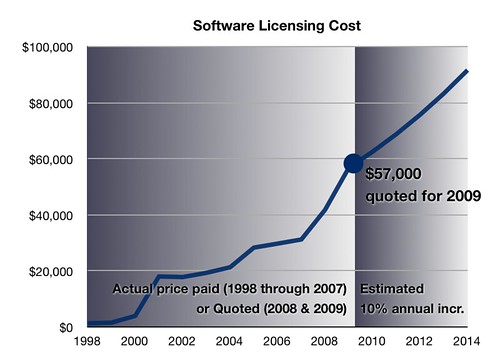Open source software of the free as in free beer and free as in free speech variety has matured to the point that there are now strong contenders in nearly every category, though that doesn’t make them easy choices. It’s often revealing when people criticize OSS as being free as in free kittens, which is true in the sense that F/OSS does require continued care and feeding to make it work, and false in that it suggests commercial solutions don’t. Indeed, as technology reaches deeper into our daily activities, the suggestion that we could make a product decision and then walk away is, perhaps, the most dangerous.
The choice between commercial and OSS is an especially interesting question in a situation I’m familiar with. When we first adopted the software in question, we had free use of it. And even when the developer began requiring annual licensing fees, the costs were initially below $2,000. In time the developer became a formal company, took on venture capital, a large staff and sales force, and eventually was acquired by a competitor. All along, the licensing costs grew, most dramatically over the past few years. The company recently quoted $57,000 in fees for 2009, and looking forward, licensing fees will likely reach $100,000 by 2015 (see graph above).
Because of the growing costs of maintaining the software, a consortium is considering pooling funds and operating a single instance to serve all members. Sometimes, the difficulty of distilling the varied needs and interests of the consortium members is worth the effort, but the vendor’s formula for licensing fees doesn’t yield a significant discount, and the consortial proposal calls for seven FTE of staff to manage and maintain the software (our own use requires .25 FTE).
This is interesting because, while writing my LTR on open source software for libraries, I had an opportunity to speak with Maureen Sheehan, technology integrator for a public school district in southeastern New Hampshire. Open source is relatively common within higher ed, but if there’s anything to stereotypes, universities are rich with staff and other resources while our public schools are in quite the opposite position. Is free software the sole provence of the privileged?
As it turns out, no. Sheehan was speaking to me about her experiences with Moodle, an open source application in the same market as the commercial software that’s becoming so expensive for us now. Moodle is a learning management system, or LMS, that helps teachers deliver instructional content online, as well as offer online class discussions, tests, and quizzes and allow students to submit homework assignments online. Here’s Sheehan’s story from the LTR:
Sheehan says she started looking at the software when a teacher who was familiar with it from another school system requested it. Sanborn didn’t have an LMS, so she mentioned it to the network administrator, who was able to get Moodle up and running in a day. “And he was able to get all the students imported, so they could use it quickly.”
With the project now in its second year, Sheehan says “I love it, it’s wonderful for our district,” adding that it’s “very convenient. It’s improved communication with our students.” She offers the story of a math teacher who posts all his homework assignments for all his classes in Moodle, “so students and parents can always see what’s been assigned, and download the worksheets,” as well as the story of an English teacher who asks students to continue in-class discussions of their reading online in Moodle.
Noting an upcoming requirement from the state that students maintain portfolios of their work, Sheehan says the district is planning to use Moodle as an “e-portfolio system.” The school system’s earlier leap to open source, as it turns out, has positioned it well for the new requirements and will save it from having to buy a commercial product.
And the price was one of the biggest selling points. “The fact that it was free gave me more confidence,” says Sheehan, who notes that so far the only costs have been for time spent training the teachers.
Do the math on what Sheehan’s district is paying for Moodle. The software is free, Sheehan and the network administrator are supporting it along with their other responsibilities, and the training is the same as for a commercial alternative. Even better, Moodle might save the school as much as $25 per student/year for a commercial portfolio system, a lot of money for any district.
Now do the math comparing Moodle to the commercial product we’re now using. Using Sheehan’s experience, it appears that staffing requirements may be lower than for the commercial solution. And using the free kittens metaphor, it seems that the money saved from not licensing the commercial product can be invested in additional staff to develop new features or offer more support to instructors.
The most difficult aspect of this is the cost of switching applications — the cost of re-training a user-base that may range from indifferent to change-opposed. And that’s where F/OSS becomes most interesting. Commercial vendors tell us we can’t afford to develop software that delivers the features they offer, but at the end of the day it’s the people on the ground that make it work. Where better to spend the money, on a far away vendor or on building a strong staff that can act and lead locally?
